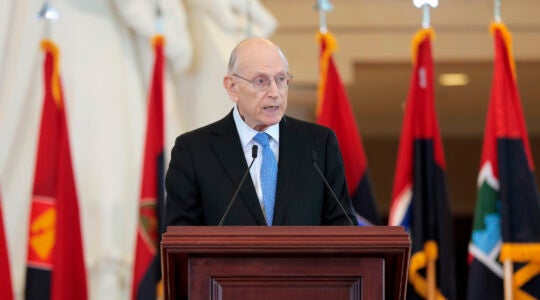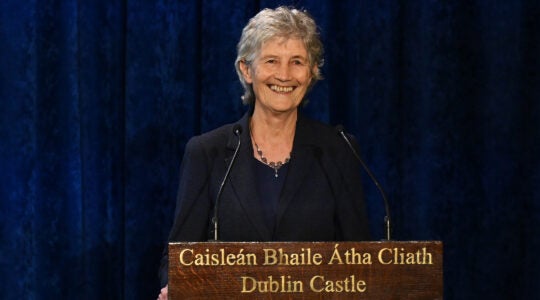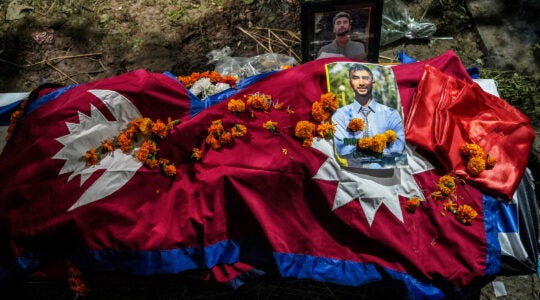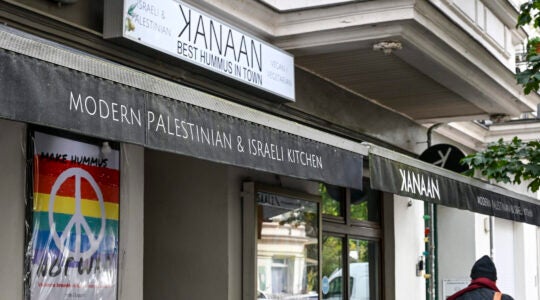
Clinic co-director Nachi Klein in the Uman Emergency Clinic ambulance, Sept. 16, 2012. (Cnaan Liphshiz)

Uman Emergency Clinic head nurse Leonid Schpitz, right, and co-director Avigdor Landesman, second from left, discussing a medical case at the entrance to the clinc, Sept. 16, 2012. (Cnaan Liphshiz)

Four paramedics welcoming a patient at the entrance to the Uman Emergency Clinic, Sept. 16, 2012. (Cnaan Liphshiz)
UMAN, Ukraine (JTA) — Like an extra in a spaghetti Western, a young Israeli man is catapulted straight out of the doorway of the Uman Emergency Clinic.
Furious, he tries to re-enter but changes his mind after receiving another forceful shove from Leonid Schpitz, head nurse and chief bouncer.
Schpitz, a burly man with a low tolerance for misbehavior, belongs to a team of 10 medical professionals — only some of them Jewish — who staff the clinic in this small Ukrainian city every Rosh Hashanah, when tens of thousands of Jewish followers of the Breslaver rebbe pour into Uman.
The Breslavers — most of them Chasidim but many of them fellow travelers — come to Uman to pray near the grave of their rebbe, Rabbi Nachman of Breslav, who founded the Breslaver movement. He died in 1810 at the age of 38. Nachman had no heir, so his gravesite remains the closest his devotees can get to their rebbe, and it has become a major pilgrimage site. Rosh Hashanah is the climax of the pilgrimage, when up to 30,000 Jews arrive in the city, sleeping in tents, cramped rental apartments and villas.
Uman has numerous synagogues, ranging from shuls with seating for thousands to cramped rooms no larger than studio apartments. The busiest, Heichal Zion, stands on a hill overlooking the grave site. It can hold about 1,500 people, but at least 5,000 congregate outside its walls to pray on Rosh Hashanah. Many Jews also pray on the streets in groups of 10 to 50.
Most of the pilgrims are Israeli, and some are new recruits to the movement from Israeli prisons and neglected urban areas, where Breslavers (also pronounced Bratslavers) do much of their outreach work.
It all makes for a raucous atmosphere on the eve of Rosh Hashanah in Pushkina, the Uman neighborhood where most of the Jewish pilgrims stay. The streets are bustling with men, many of them wearing festive white robes. Negotiating a path between the large potholes that scar the asphalt of Uman’s poorly lit streets, they pop in and out of the yards of houses that their friends are renting from locals. Children scamper all around, even on rooftops. Some men engage in group hugs and conversations about spirituality, while next to them groups of young, excitable men shove, curse and shout as they roam the small area looking for trouble. Stabbings occur here almost every year, and visitors sometimes try to steal medicine from the Uman Emergency Clinic, according to its staff.
During the pilgrimage season, the clinic treats patients for free, dealing with everything from life-threatening injuries or illnesses to mild cases of the flu and even homesickness.
“In this foreign, unfriendly place, we are more than a clinic,” says Yossi Lifshits, a paramedic from Jerusalem who has been working at the clinic for six years. “We are a piece of old familiar home, a place where you can get a warm cup of tea and talk about your problems.”
Running the clinic during the chaotic holiday requires a firm hand, says Avigdor Landesman, the clinic’s New York-born co-director.
“Here, even a mild cold can turn the pilgrimage into a nightmare,” Landesman tells JTA. “Before there was a clinic, a high temperature or a heart tremor meant a 200 kilometer [about 125 miles] drive to Kiev. Now it can be easily treated right here.”
The clinic has three hospital beds and is equipped with an electrocardiogram, defibrillator and resuscitation machines, as well as several tons of other medical equipment, and Israeli and American medicines. On some days the staff treats more than 400 patients, pulling 16-hour shifts.
“The primary goal is saving lives, but the secondary goal is giving quick service so people can return to pray right away,” says Nachi Klein, the clinic’s co-director.
Most of the staff are not Breslavers. Schpitz and nurse Simon Eisenstadt were both born in Ukraine before immigrating to Israel and do not regularly wear a kipah. Dr. Ahmed Yunis is one of two Israeli Arabs on the team.
It’s the team spirit that brings Yunis back every year, he says.
“I don’t feel any connection to the spiritualism here, and I’m a pretty spiritual guy,” he says. “I just like the team, I like working with good people. It’s hard work but good money.”
As Rosh Hashanah begins, radios are switched off and the small clinic is filled with the sounds of the dozens of men praying. Yunis cleans the raw stitches of a patient who had his lymph glands surgically removed just days earlier.
“He shouldn’t be traveling anywhere, but go tell that to religious people,” Yunis says, shaking his head after the patient leaves. Later he tries to persuade a patient who is “on a spiritual journey purification” to drink cough syrup despite the small amount of alcohol it contains.
Next, three young men storm into the clinic leaving a bloody trail. They stepped on broken glasses upon entering a nearby lake, which they used as a mikvah, or ritual bath, for a purifying dip before the holiday. Locals scatter the shards deliberately along the banks, Schpitz says.
Outside the stitching room, three asthma patients inhale fumes from a row of buzzing nebulizer machines.
During the holiday, the clinic will treat several heart patients and evacuate one of them to Kiev. But mostly the clinic treats cases of indigestion, diarrhea, ingrown toenails, scrapes and blisters.
“Yeah, we get lots of nudniks,” Yunis says, using the Yiddish term for “pains in the neck.”
Landesman has been running Uman’s Rosh Hashanah clinic for the past few years. In his regular life he works for United Hatzalah, the Orthodox Jewish emergency services organization also known as Hatzolah. Along with the Orthodox rescue and relief group ZAKA, Hatzolah provides most of the clinic’s annual budget of approximately $70,000.
A native of Monsey, N.Y., now living in Israel’s Galilee region, Landesman first came to Uman as a kitchen worker 17 years ago. It was shortly after the fall of the Iron Curtain, around the time that Rosh Hashanah started to turn into a massive pilgrimage holiday here.
The clinic was established the following year in a rented apartment by Rabbi Menachem Mann, a well-known and well-connected Breslaver from Israel. Schpitz, who has experience working with haredi Orthodox patients, was its first nurse.
This year marked the first time that the clinic operated from a prefabricated house inside the main compound of the World Breslav Movement, which coordinates much of what goes on in this Uman neighborhood.
Klein says he sees the clinic as a religious mission.
“After the holiday comes the day of reckoning,” Klein says, referring to Yom Kippur. “Just like all the others here, I came to get the best lawyer in the world, Rav Nachman, to argue for me.”
JTA has documented Jewish history in real-time for over a century. Keep our journalism strong by joining us in supporting independent, award-winning reporting.





